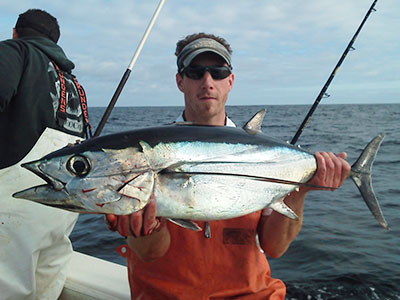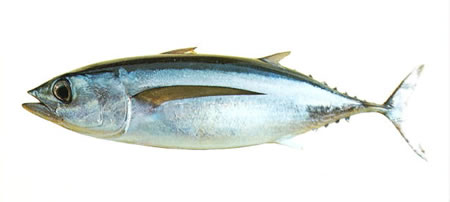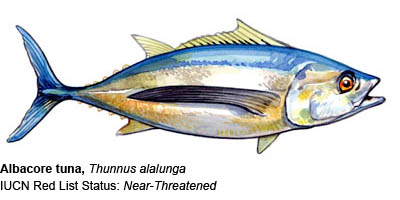
Thunnus alalunga
FAMILY
Scombridae
TAXONOMY
Thunnus alalunga (Bonnaterre, 1788), Sardinia.
OTHER COMMON NAMES
French: Germon; Spanish: Atъn blanco.
PHYSICAL CHARACTERISTICS
Maximum fork length 50 in (127 cm). A large tuna, deepest at
a more posterior point than in other tuna species, at or only
slightly anterior to second dorsal fin. Two dorsal fins, separated
by only a narrow interspace, the first with 11–14 spines,
the second with 12–16 rays; anal fin with 11–16 rays; both second
dorsal and anal fins followed by seven to nine finlets. Pectoral
fins remarkably long, usually 30% of fork length or
longer, reaching posteriorly well beyond origin of second dorsal
fin. Teeth small and conical, in a single series. Gill rakers,
25–31. Caudal peduncle very slender with a strong lateral keel
between two smaller keels. Corselet of large scales anteriorly;
rest of body covered with small scales. Swim bladder present.
Ventral surface of liver striated. Back metallic dark blue; lower
sides and belly silvery white; second dorsal and anal fins yellow;
anal finlets dark; white margin on posterior margin of
caudal fin.
DISTRIBUTION
Cosmopolitan in tropical and temperate waters of all oceans
and Mediterranean Sea, north to 45–50°N, south to 30–40°S.
Offshore often extend into cooler waters.
HABITAT
Epipelagic and mesopelagic zones of ocean; abundant in surface
waters of 60.1–66.9°F (15.6–19.4°C). Deeper-swimming
large albacore are found in waters of 55.9–59.4°F
(13.3–15.2°C).
BEHAVIOR
Throughout their range, albacore migrate over great distances
and appear to form separate groups at different stages of the
life cycle. At least two stocks, northern and southern, are believed
to exist in both the Atlantic and Pacific oceans.
FEEDING ECOLOGY AND DIET
Feeds on crustaceans, fishes, and squids.
REPRODUCTIVE BIOLOGY
Albacore tend to spawn in subtropical waters, although they do
spawn in tropical waters in some places. Albacore mature at
approximately 5 years of age and 35 in (90 cm) fork length in
the Atlantic Ocean. Fecundity increases with size generally. A
44-lb (20-kg) female may produce 2–3 million eggs per season
released in at least two batches.
CONSERVATION STATUS
Listed as Data Deficient by IUCN.
SIGNIFICANCE TO HUMANS
There are important fisheries for albacore in the Atlantic and
Pacific oceans. FAO catch statistics for 1991–2000 show catches
of 185–280 thousand tons(168–254 thousand metric tons) per
year by 59 countries. The highest landings reported for 2000
were by Japan, 69 thousand tons (62.6 thousand metric tons),
and Taiwan, 57.0 thousand tons (51.7 thousand metric tons).
With increasing effort in surface fisheries, the world catch has
been gradually declining, particularly in the Atlantic Ocean. Albacore
are caught by four types of fishing operations: long lining,
live-bait fishing, trolling, and purse seining. Albacore is
packed as “white-meat” tuna. The all-tackle game fish record is
an 88-lb (40.0-kg) fish caught in the Canary Islands.
Other popular Animals
Photo Gallery of - Albacore





 Animalia Life
Animalia Life